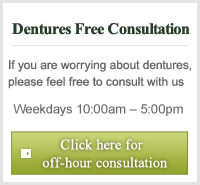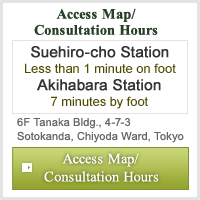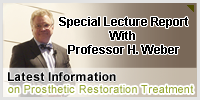2009年4月21日
In order to live happily, you must be able to chew healthily
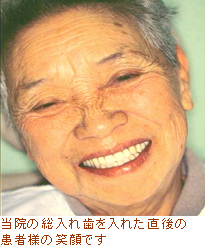 + Are you able to enjoy your meals comfortably every day?
+ Are you able to enjoy your meals comfortably every day?
Meals are enjoyable. They give us a reason to look forward to the day and provide our lives with a sheen. The importance of dining cannot be understated. It may be a slight exaggeration, but losing the ability to enjoy a meal is enough to snatch away the meaning of life. Also, smiling and laughing with our families and friends is extremely important to our lives.
What we aim to do is allow our patients to enjoy a rich lifestyle by helping them recover the joy of eating and laughing.
Dentures that you will forget you are even wearing
A good phrase that briefly sums up our products is, 'Dentures that you will forget you are even wearing'.
For example, one of the features of some of our partial dentures is that they do not use clasps (springs), but rather they use a double construction in which we make inner crowns for your molars and place outer crowns over them. Because of this, there is no awkward feeling to the tongue and there is almost no feeling that the dentures are in place. Also, since these dentures do not place an extra burden on other teeth, there is no reason to worry about losing other healthy teeth.
Because our dentures are made using calculations of your mouth movements
Our full dentures are made using calculations of your mouth movements. This means that when you use them, they will feel like a part of your own body. They are so much like natural teeth that you can actually sleep with them still in.
See here in order to learn more about our 'full dentures'
See here in order to learn more about our 'partial dentures'
Did you know that you can lose teeth because of dentures?
Partial dentures covered by health insurance are the type that attach and detach using clasps that hook onto healthy teeth (metal springs). Many people probably use them because they are reasonably priced and easy to obtain.
Clasps place a burden on the teeth they hook onto
But did you know that each time that you attach and remove these dentures, and every time you chew food, they are placing a burden on the teeth that they are hooked on to? In the worst case scenario, it is possible to lose even healthy teeth. For this reason, all countries advanced in dental technology, starting with Germany, have ceased using these clasp-style dentures.
[Telescope system dentures] increase the lifespan of your remaining teeth
At our clinic, we use telescope systems such as 'Riegel telescope' that prevent further tooth loss by securing all of your remaining teeth and reinforcing them. This increases the lifespan of your remaining teeth.
See here to learn more about the 'telescope system'
Being able to chew also prevents complications associated with aging
There is nothing more joyful than being able to eat whatever you want and laugh heartily before people. Recent research suggests that the teeth are not just for eating and talking but are more deeply connected with the overall health of the body.
Biting slows down the aging process of necessary muscles
We are able to bite precisely because we have teeth. We usually don't pay much attention to biting, but with every bite we crush food, mix it with saliva, and shape it into a clump for easy swallowing. But these are not the only functions of biting.
The existence of teeth help us form facial expressions and communicate. Moreover, the workings of the jaw while biting are important to the health of our whole bodies.
The forces exerted when biting actually slow down the aging process of these muscles. Yes. This means that biting has a rejuvenating effect on us!
The brain is stimulated and activated by chewing
Also, when the upper and lower teeth come into contact through a strong force, the power exerted by the lower jaw is absorbed in the upper jaw. This impact transfers from the jaw to the head and is absorbed by the skull. This means that the brain is stimulated and activated through chewing. Conversely, it has been reported in research that the brain ages faster when people lose their biting functions.
It is necessary for those who have lost their teeth and cannot bite to get treatment in order to regain the ability to bite well. There are many various options including dentures and implants. Please consult with us so that we can find the best option to help you live comfortably.
Dentures that can be used for decades
+ How many times have you needed to have your dentures remade?
There is no need to have dentures from our clinic remade. We even have some patients who say, 'I have had numerous sets of dentures made, but these will be my last'.
Characteristics of dentures made at our clinic
+ firm and sturdy fit
+ stability that places no extra burden on other teeth
+ natural fit that feels like your own teeth
Let this be the last time you ever get your dentures remade
By making detailed adjustments to dentures made at our clinic during maintenance visits, our dentures can be used continuously for decades. We have many patients who have actually been using the same set of dentures made here decades ago. Also, not only do we make dentures, we aim to be a warm and welcoming dental clinic connected to our patients through a relationship of trust. We set a lofty goal of 'helping our patients regain their health'.
We can confidently treat cases considered difficult by other clinics. Our lower jaw dentures are especially reputed to be very stable. If you are worrying about dentures, please contact us for consultation.
How do our dentures differ from ones covered by insurance?
Concerning full dentures covered by insurance, it is possible to have soft dentures made within the scope of health care services provided by health insurance. So why don't we recommend those dentures at our clinic? There are a few reasons.
First, the greatest difference is the knowledge that our specialist dentists and technicians possess.
In order to learn German denture technology with a long history, our dentists and technicians are required to possess vast stores of high-caliber knowledge in their field. They cover every possible angle to design dentures for our patients that can be used for a long time.
The condition of patients' teeth is never the same
There are many differences in bone condition, the presence or absence of nerves, number of teeth, tooth position, and many other variables. You should be aware that there is no guarantee that you are getting the best design possible with health insurance-covered dentures since they are limited by design parameters and rules.
Also, materials are a problem
Since insurance-covered dentures are made with a soft resin, they absorb stains from food, coffee, and tobacco. Stains and foul smells sink into the resin and may cause bad breath. Also, prosthetic teeth are limited to prefabricated plastic teeth. They lack the hardness and grooves that occur with natural teeth making it difficult to chew and easy for others to notice your dentures simply by looking at them.
Next, there is the problem of time spent making the dentures
Upper and lower molds are sent separately to dental technicians who specialize in making insurance-covered dentures. The technicians never see the faces of the people whom they are making dentures for. They also use the most economically reasonable materials. Since the muscles of the mouth and the gums are not considered at all, many dentures made in this manner unfortunately suffer from weak adsorption and tend to fall out easily.
At our clinic we specialize in materials and production
Dentures not covered by insurance from our clinic are made by technicians who take pride in the materials and methods that they use. They use the best materials available to meet each patient's needs.
High precision Ivocup System
First of all, for materials, we use a low-water absorbing material that doesn't let smells or stains soak in, making our dentures more hygienic. This is because we use the high precision Ivocup System which applies 2 tons of pressure to the resin making our dentures thinner yet stronger and more resistant to water absorption.
Artificial teeth from Liechtenstein Ivoclar nearly indistinguishable from natural teeth
We use Liechtenstein Ivoclar artificial teeth which as functional as real teeth and we allow you to choose from a large selection of colors. These teeth feature strong natural grooves that allow you to crush and grind food as if you were using your natural teeth.
We are able to make detailed fine adjustments quickly since our technician is in-house
Our dental technicians who specialize in constructing non-insurance-covered dentures are located in the annexed dental lab in our clinic. The dentists and technicians work together to make dentures that fit our patients perfectly. Since the technicians are located onsite, we can also quickly handle detailed fine adjustments. Your mouth muscles support these dentures through adsorption making them more secure the wider you open your mouth as you laugh or sing. Rarely can anyone notice patients wearing a set of our dentures and your pronunciation will also improve greatly.
2009年4月20日
Can you eat anything with your current dentures?
Can you eat steak or firm bread with the full dentures you are using now? Can you eat anything you want with your current dentures?
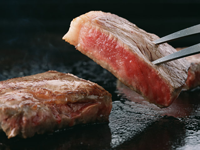 It is not so difficult to bite into hard foods, but it can be difficult eating foods that require some chewing.
It is not so difficult to bite into hard foods, but it can be difficult eating foods that require some chewing.
It is said that biting directly into foods that have a slight crunch, such as spring rolls and pies, or fruit with the skin on it, is very difficult with dentures. Some people find it difficult to bite into vegetables like lettuce.
Can you laugh or speak in a loud voice in front of people?
Many patients with full dentures worry about them falling out, have difficulty speaking clearly, and shy away from speaking in the presence of other people. This can have unfortunate consequences on their lifestyles.
Our clinic uses the 'maxillomandibular simultaneous impression method', a method modeled after Strack dentures developed in Germany, in order to provide our patients with the ability to eat what they want to eat, laugh with their mouths wide open, and perform other actions usually taken for granted.
"Full dentures made using the maxillomandibular simultaneous impression method"
The prototype used for "full dentures made using the maxillomandibular simultaneous impression method" were dentures made by Dr. Reiner Strack. Dr. Strack was a master of full denture manufacturing from Tubingen University, the university where Dr. Shigeru Inaba stayed as an exchange student. He was succeeded in his craft by Dr. Hans Schleich.
When Dr. Strack retired, all of his research materials were entrusted to Dr. Shigeru Inaba. Currently Dr. Shigeru Inaba is the only dentist who teaches the manufacturing process of Dr. Strack's dentures in their original design. Dr. Shigeru Inaba has transmitted this knowledge to dentists throughout Japan.
Pattern of patient training of three days here
Reception
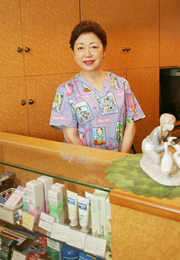 This is our clinic's reception area. Dental hygiene products are lined up neatly and orderly in our show window. Medical records are stored properly in special shelves. We try not to look too much like a stereotypical dental clinic.
This is our clinic's reception area. Dental hygiene products are lined up neatly and orderly in our show window. Medical records are stored properly in special shelves. We try not to look too much like a stereotypical dental clinic.
Dentures that truly fit will give you a brighter face
People who have lost all of their teeth tend to look older since the bone around their mouths thins out and causes an emaciated look.
Dentures that are made with patients' bone quality and mouth movements in mind can restore those patients' features lost due to tooth decay.
Strack dentures made using the 'maxillomandibular simultaneous impression method' can add volume to the inner mouth which enables the dentist to adjust the appearance of the area around the mouth freely. This means that patients are able to have their youthful appearances restored.

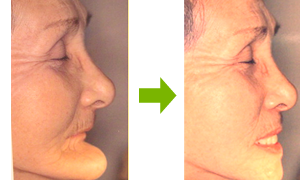 Dentures that fit correctly can actually change peoples' expressions. When patients remove their dentures, the area around their mouths sinks and they look older than they are. But with full dentures, they will look noticeably younger and brighter.
Dentures that fit correctly can actually change peoples' expressions. When patients remove their dentures, the area around their mouths sinks and they look older than they are. But with full dentures, they will look noticeably younger and brighter.
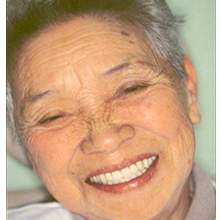 Strack dentures are superior esthetically as well as functionally.
Strack dentures are superior esthetically as well as functionally.
We make full dentures that allow our patients, young and old, to enjoy eating and talking every day.
Don't think of getting dentures as 'giving up'. The picture to the right shows one of our patient's beautiful smiles right after she got dentures. This smile says all that needs to be said about the comfortable fit of our dentures. A comfortable mouth will lead to a brighter disposition.
Our clinic provides the best treatment available to make sure that your patients can regain the comfortable smiles that they had before they lost their teeth.
We make German-style full dentures designed based on a 3-D model of the mouth
How do you get dentures to firmly stay in place?
Your oral functions are extremely important to eating. The way that you use your tongue and pronounce words is exactly the same with our full dentures as it is would be if you had all of your original teeth. (This drawing comes directly from the master, Dr. Hans Schleich's resources and shows full dentures.)
For example, when people eat, first they press their tongues against the upper jaws and gradually move the food back of the throat for swallowing. In the case of full dentures, these tongue movements make it easy for the dentures to slip out of place, so it is necessary to stabilize the dentures where the tongue comes into contact with them as it is pushing food towards the back of the mouth.
Also, in order to secure dentures and make sure they stay in place, it is best to place prosthetic teeth in the same position that natural teeth were in before they fell out.
How do you create full dentures that are modeled after a mouth with a full set of teeth?
How can we measure mouth movements and the shape of the mouth with all of its teeth when making dentures? The answer is simple. We make a 3-D copy of the condition of the mouth and design dentures that fit perfectly into that model. It's just that easy.
But there are not many dentists who make dentures in this way. The reason for this is that equipment and technology used to make a full 3-D model of the mouth is extremely high-tech.
High-tech mold-taking [maxillomandibular simultaneous impression method]
A mouth with a full set of teeth maintains a good balance with pressure from the cheek muscles pressing in from the outside and pressure from the tongue pushing out from the inside. When people lose their teeth, the cheek muscles continue to push from the sides and the lips from the front, but the tongue no longer has the teeth acting as outer support.
Because of this, the tongue tends to spread out more than when teeth were still present creating the illusion that there is no room for teeth. This makes taking a mold of the oral condition without teeth very difficult.
However, our clinic's 'full denture manufacturing method through maxillomandibular simultaneous impression method' is calibrated to account for the patient's original muscular state which gives us a perfect recreation of the patients teeth made from their own natural mouth movements.
What do you mean by a method that perfectly reproduces the inside of the mouth?
We make our dentures keeping in mind the way the mouth moves when 'swallowing'
Try to imagine the way that muscles in our mouths move when we eat. It is easy to imagine if you swallow some saliva. Our clinic's full dentures are designed with these 'swallowing' mouth movements in mind.
You may think, "How on earth can you model swallowing movements?" When we use the 'maxillomandibular simultaneous impression method' to take a mold of your mouth, we will ask you to swallow. Of course this was impossible to do with the conventional modeling procedure where molds were taken of the upper jaw and lower jaw separately.
And, of course there are some preparations that need to be made before taking the final mold. Beforehand we must confirm the height of the dentures and whether or not they are centered and bilaterally symmetrical. Then we can use this information to make a specialized tray.
Dentures that provide the tongue with full natural movement
One of the disadvantages of conventional dentures is that in order to achieve stability, the shape of dentures was typically extended to reach behind the tongue in the lower jaw. The dentures would not come out if the tongue was not moving but even if the tongue moved slightly, they were in danger of slipping out of place. It is impossible not to worry about every tongue movement under these conditions.
However, full dentures made with the 'maxillomandibular simultaneous impression method' make use of the soft area towards the front of the tongue, leaving the tongue to move freely.
Also, when people lose their teeth, their bone becomes thinner. The part of the dentures known as the bed (the pink plastic part) makes up for this. The more area the bed has, the stronger the adsorption power of the dentures.
How are your dentures?
Superior dentures are made by lining up artificial teeth where they can maximize adsorption and maintain a balance between the support of cheek muscle force, the lips, and the tongue.
If this balance is off, only the lower teeth may be visible when smiling, or one's facial expression may appear squished with a lowered bite. The ideal denture shape should allow for all teeth to be seen when smiling.
Japanese dentures covered by insurance are not even used overseas
Currently dentures that are covered by Japanese health insurance use metallic springs called clasps. The clasps clip onto the teeth but they do not do so through adhesion.
Because of this, when the dentures move, the teeth move with them, which eventually leads to more teeth coming loose and falling out. Since the teeth are supported by springs, the dentures are constantly moving around in the mouth.
When we dentists extract teeth, we do so by wiggling the problem tooth side to side. This is the exact same movement that the clasps of these dentures causes to the teeth they are latched onto.

^Partial dentures covered by insurance. The metal clasps place a burden on the teeth, which can be seen easily in this image.
In Germany, outdated denture technology that makes use of clasps has already been purged from dental university classes due to the damage they can do to teeth.
Here we answer some questions from our patients
Concerning the differences between implants and partial dentures
Q.I have a question about implants and partial dentures. (60 year old women, N.I.)
I am quite worried. In the past I have had my inner-most molar removed and have had a bridge made from the second tooth on one side of my mouth. However, the second tooth has cracked and now I am missing 3 molars. I also have a bridge on my molars on the other side. Lately all of my teeth seem to feel loose. When I went to the local dental clinic, they recommended partial dentures or implants. I was told it would cost from 220,000 to 280,000 yen for implants.
I have a few questions concerning what I was told.
+ Between implants and partial dentures, which would be better for me?
+ Is the price range of 220,000 to 280,000 yen typical for implants?
+ How is the usability of partial dentures?
To be honest, I feel resistant to the idea of getting dentures. 2 years ago I was diagnosed with osteoporosis and I had to have hip surgery. I also have slightly high blood pressure so implants frighten me a little as well...
A. A. First, let me tell you a little more about what implants are.
The roots of healthy teeth are firmly fused to the jaw bone and are covered with a cushion called the periodontal membrane. The gums function as a cover over this layer of cushion. Meanwhile, implants are constructed to be similar in structure and the roots are made from titanium, a safe metal. Implants can be fused to the bone and function in the same way as natural teeth. It is a wonderful treatment method that allows people to regain their lost teeth.
Our clinic's implant treatment process is extremely safe. This is because we work in cooperation with implant specialists and oral surgeons from university hospitals. However, there are cases in which implants are not appropriate.
Situations where implants are not suitable
Bone amount
Strong and sturdy bones are needed to support implants. (If the amount of bone is not enough, then more bone must be made.) If the foundation is not strong enough, then implants will prove ineffective as a treatment method. It is the same principle as in when building a house. We can determine through X-rays and CT scans if the bone is sufficient to support implants.
Gingivitis
Gingivitis is the greatest adversary to implants because it can be absorbed into the bone that supports them. For example, it is possible that even if the implants are put in right at the time, people with a tendency to get gingivitis will notice it effecting their teeth. After a while the implants may come loose...
Smoking
Surprisingly, this is not a very well-known fact. Smoking is not only a cause of gingivitis, but it is also a great adversary to implant treatment. Smoking causes constriction of the blood vessels which obstructs blood flow inside of the oral membrane and lowers the immune system throughout the entire mouth. This hinders healing after implant surgery, prevents recovery from gingivitis, which leads to inflammation around the implants, and can lead to many other detrimental effects.
Systemic illnesses
Since implants require treatment that can result in blood loss, people with chronic illnesses such as diabetes or high blood pressure must be kept under favorable conditions. Implant treatment is also not allowed for people with osteoporosis.
At our clinic, we inquire about all of these factors beforehand and only provide implant treatment to patients whom are deemed to be healthy enough.
Answers
Q. Between implants and partial dentures, which would be better for me?
A. Partial dentures would be better in your situation, Ms. N.I.
Why?
+ You feel that all of your teeth are loose.
+ You have osteoporosis.
+ You have high blood pressure.
For these reasons we would not recommend implants in your case.
Q. Is the price range of 220,000 to 280,000 yen typical for implants?
If you go to a dental clinic that provides top-quality surgery, the usual cost for implants in your situation would be 400,000 to 600,000 yen. Dentists who specialize in implant surgery technology can charge a lot of money. The materials used for the procedure are also very expensive and there are various expenses related to the establishment and upkeep of implant surgery facilities. I would be more worried in your case about this quotation being too low. It seems a little questionable to me.
Q. How is the usability of partial dentures?
Here I would like to introduce the partial dentures we make at our clinic.
Telescope system
The mainstream treatment for tooth loss is implants. However, implants cannot prevent further tooth loss. Many elderly patients tend to have other diseases as well, such as gingivitis or weak jaw bones due to osteoporosis. This makes it impossible to treat tooth loss with implants. Also, dentures that are covered by insurance use clasps that grip onto remaining teeth which adds an extra burden to healthy teeth. This ultimately leads to further tooth loss.
At our clinic the telescope system usually covers every case.
One type of telescope system is called Riegel telescope. Riegel, in Riegel telescope means 'bolt' (as in a deadbolt). These dentures are equipped with a small locking mechanism. They can be attached and removed by simply opening and closing the lock.
Also, they may be used for many years since they can be adjusted to fit the patient's oral condition. They also prevent further tooth loss since they link all of the teeth together and hold them firmly in place.
Riegel telescope is a safe treatment method that I recommend for people with systemic illnesses like Ms. N. I.
Also, even if a patient suffers from gingivitis, these dentures can strengthen their teeth by fixing remaining teeth into place. And should the patient end up losing any more teeth, they can be adjusted to the oral condition and continue to be used. With conventional dentures it is necessary to have them remade from scratch every time a tooth falls out, but with Riegel telescope dentures, the same set can be used for life.
It is a national characteristic of Germans to take care of things, repair them, and continue to use them for a long time. The same is true for dentures, and Riegel telescope has more than 100 years of history. This telescope system has been improved and used to treat patients countless times over the years.
I must also mention here the comfort of Riegel telescope dentures. They attach into place easily and comfortably and there is no awkward feeling to the tongue which makes these dentures so natural feeling that you may forget that you are even wearing them.
The high quality of Riegel telescope technology is attested to by a number of patients who received treatment over 31 years ago when Inaba Dental Office's advisor, Shigeru Inaba, first brought the technology over from Germany. Even today they are still using the same pair of dentures from that time. Over the last 31 years, Inaba Dental Office has treated over a thousand cases using the Riegel telescope treatment method.
2009年4月19日
Pictured is a comparison of health insurance-covered dentures and dentures made using the maxillomandibular simultaneous impression method
The smaller dentures were made using health insurance. The larger ones are dentures made using the maxillomandibular simultaneous impression method.

You probably can't tell but these are two sets of dentures made for the same person. You can see how much of a difference the manufacturing method makes.
Insurance-covered dentures are made by simply taking a membrane mold which often results in small dentures. They tend to move around in the mouth and in some cases people can even swallow them.
Dentures made using the maxillomandibular simultaneous impression method, however, are made by recording every piece of information possible concerning the inside of the patient's mouth.
Waiting Room
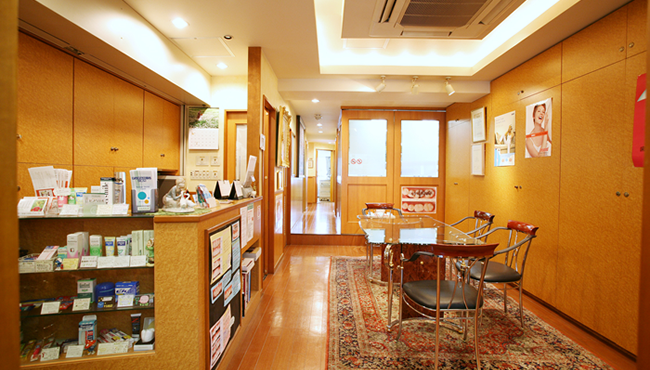
This is our clinic's waiting room. It features Italian furniture set on a carpeted floor as we strive for a more at-home feel. Directly next to the waiting room is our private counseling room. Here we can talk with patients on a more private level.
What are 'telescope' precision long-lasting dentures?
Did you know that Germany, the leading country in dental treatment, uses dentures known as 'telescope'? These are different from insurance-covered dentures that use metal springs as a retention mechanism. Instead, they are known as 'inlay style' dentures.
Dentures from Germany, the most advanced nation in denture technology (Riegel telescope)
Our clinic deals in dentures from Germany, the most advanced nation in denture technology (Riegel telescope).
Telescope denture technology began in 1886 and has more than 120 years of history. This technology has evolved and gone through many revisions to become the most precise and most highly regarded denture technology today.
You can have them made once and use them for a lifetime with only minor adjustments
Quality products may be costly, but this high quality and long-lasting treatment, born of the ingenious thinking of German dentists, is worth the investment. In Japan, dentures usually need to be remade from scratch if they do not fit or if they break, but these German dentures are made once and can be adjusted many times to fit the changing condition of the mouth.
Almost 30 years have passed since the advisor of our clinic, Dr. Shigeru Inaba, first introduced German Riegel telescope technology to Japan. You can see the superiority of this German technology in the fact that some patients who received treatment at that time are still using the same dentures today.
<Our clinic's telescope systems
+Riegel telescope
+Konus telescope
+Resilience telescope
There are many variations of this technology in Germany, but the three kinds offered at our clinic, Riegel telescope, Konus telescope, and Resilience telescope, together are suitable for nearly every case.
<Hear from our patients>
A 45 year old man who was treated with the telescope system
It was even better than I imagined.
A 59 year old man who was treated with Resilience telescope
I regret not asking about them earlier.
Special features of dentures made using the telescope system
Below is listed a summary of the special features of dentures made using the telescope system.
Special features of the telescope system
+ Since there are no visible metal clasps, no one can tell that you have dentures.
+ Since there is no need to remove them before going to bed, they become a part of you.
+ They will not come off while you eat.
+ There is no awkward feeling of having a foreign object in your mouth, making for a comfortable fit.
+ Like implants, they are esthetically superior.
+ They protect your remaining teeth from further tooth loss.
(The linking and fixing functions keep your teeth from moving)
+ They can be adjusted to the changes in your mouth that occur throughout the years so that they can be used for a very long time.
(Dentures covered by health insurance must be remade from scratch each time you lose a tooth)
An Introduction of Cases Treated With the Telescope System
Here we will introduce a few cases that were treated using the telescope system.
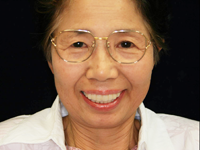 One of our patients had her upper jaw treated using Riegel telescope and her lower jaw treated using Konus telescope. She told us that the first one to notice her transformation was her grandchild.
One of our patients had her upper jaw treated using Riegel telescope and her lower jaw treated using Konus telescope. She told us that the first one to notice her transformation was her grandchild.
She says her grandchild said over and over again, "Grandma, your teeth are so beautiful!"
Before she came to Inaba Dental Office, she had been receiving treatment over the last 3 years from a clinic introduced to her that was a 30 minute walk from where she lived. She said that even after treatment, she still could not bite. She was very eager to be treated at our clinic and she told us after treatment that the results were even better than she had hoped for.
She shared with us the following:
"My case was very serious and I used to say, 'No matter how much I try to explain the pain of eating, no one understands.' I never would have thought using my front teeth would be so easy after putting in my Riegel telescope dentures. I can even eat corn on the cob and pickled vegetables!"
Nothing encourages us more in our clinical operations than hearing the joyful voices of our satisfied patients.
2009年4月18日
Locking partial dentures [Riegel telescope]
Riegel is German for 'bolt' (as in a deadbolt). Riegel telescope dentures use a bolt-like locking mechanism as retention equipment.

There is a small lock on the inside of the dentures. When the lock is shut, it is nearly unnoticeable to the tongue. Dentures can be removed easily by simply opening the lock (it is opened easily by hand).
As opposed to Konus telescope, which are retained in the mouth by the wedging power of inner and outer crowns, Riegel telescope does not exert any force on existing crowns. Also, these dentures are well-suited for teeth that are missing nerves.
Comfort that will have you forgetting that you are wearing dentures
For the most part, our dentures are so comfortable that you will forget that you are even wearing them. You can brush your teeth before you go to bed, wash your dentures, and go to bed with them still in (there is no need to worry about swallowing them while you sleep).
Only your pearly whites are visible when you smile
Where Konus telescope inner crowns are scattered about, Riegel telescope inner crowns are linked and fixed together in place. The locking mechanism is placed where no one can see it making these dentures more esthetically pleasing than those covered by health insurance. When you smile, the only thing that people will be able to see are your beautiful pearly whites!
There are many types of telescope systems in Germany, but in Japan, Konus telescope is the only one that was known.
Some types of telescope system treatment methods are Parallel telescope, Konus telescope, Riegel telescope, and Resilience telescope. Certain types are best suited to treat certain cases.
Riegel telescope is one of these methods. The first time that our advisor, Dr. Inaba, saw Riegel telescope was during his stay at Tubingen University as a visiting professor in 1978. It was a telescope method that he had not yet seen during his clinical experience.
He was determined to learn this new method in Germany and was able to treat his first patients there. While under the instruction of Professor Koerber at Tubingen University, he was able to learn the manufacturing process by observing in detail the superior work of the Master Dental Technician, Schiever.
At first glance, Dr. Inaba thought that Riegel telescope resembled a retention device that could be used as a type of detachable bridge, but he had no idea how it was made. So Dr. Inaba was allowed to carry out clinical care on patents while learning the manufacturing process from the Master. At first he had no idea how the manufacturing process worked, but he began to understand gradually as if a magic trick was being revealed to him.
He learned that Professor Strack from Tubingen University was the brainchild of Riegel telescope, and that the first people to actually make these dentures were Master Oigen Shraihi, and Professor Koerber.
Revolving Riegel (Dreh Riegel) and Swing Riegel (Schwenk Riegel) are two kinds of Riegel telescope. The manufacturing process of Revolving Riegel is quite difficult and so it is not used so often these days. Riegel lever equipment features a nook that is very narrow which makes it very convenient to use.
The 'main feature' of Riegel telescope is that retention is not dependent on inner and outer crowns, which means that they are much easier to remove. Also, retention force fixes inner and outer crowns in place through the Riegel lever (the bolt). Once the lever is released there is no resistance, making attachment and detachment easy. The 'secondary feature' of Riegel telescope is that since the device is primarily fixed into place, abutment teeth are also fixed into place. With abutment teeth fixed into place, the dentures can be used as a long-term prosthetic. Dr. Inaba has seen a number of patients who have been using the same set of dentures for more than 30 years.
In recent years this method has even been used in the upper structure of implants. The technology is becoming more compatible with CAD/CAM and these dentures are becoming more adaptable as removable upper structures.
Konus telescope
Konus means 'cylindrical' in German and dentures made through this method consist of inner crowns that attach directly to the teeth, the denture body, and outer crowns (a dual crown system).
The inner crowns are cylindrical and have a 6 degree angle (the Konus angle). Retentive force is provided by the wedging force created between the inner and outer crowns. It may be easier to understand if you can imagine two cups of the same shape stacked over each other. The dentures make a snapping sound when they are shut and they will not come off.
There is a notch in the dentures where the patient places their finger and lifts to remove them. The angle of the crowns can be adjusted to fit the condition of the teeth.
Konus telescope dentures are not suitable for teeth that lack nerves. There may also be contraindication in places where teeth remain.
Differences between health insurance-covered dentures and dentures made using the maxillomandibular simultaneous impression method
Full dentures made within the scope of health care services provided by health insurance and those paid for out of pocket made using maxillomandibular simultaneous impression method are vastly different.
Of course, dentures covered by insurance will not be perfect as they are limited by materials and amount of time and attention to detail they can spend on each set. Following is an explanation of some of the differences between health insurance-covered dentures and dentures made using the maxillomandibular simultaneous impression method.
Conventional dentures: Demerits of taking the upper and lower jaw molds separately
1. Since the patient opens their mouth and has the upper and lower tooth mold taken separately, errors can occur in placing the mold device in the mouth. As a result of this, the patient must make extra visits to the clinic (anywhere from 6 - 10 times).
2. This method is incapable of recording data concerning the movement of muscles around the mouth, the tongue, and the lips while functioning.
3. It is also incapable of simulating the state of the mouth while eating by measuring movements when the patient swallows saliva.
4. The pressure used to make the mold varies for the upper and lower jaw.
5. The natural pressure of the mouth is different from that used to make the mold since the dentist decides what pressure to use when taking the mold.
6. The natural bite pressure is different from that used to make the mold since the dentist takes the mold manually.
Dentures from our clinic: Merits of using the maxillomandibular simultaneous impression method
1. Since we take precision molds, record bite alignment data, the height of the upper and lower jaw, and tooth position all at once, there is no need to come back for mold taking over and over again like with conventional dentures. *The process is complete in just 3 visits.
2. We make the mold while recording the bite alignment height which achieves an ideal balance.
3. We have you swallow saliva while taking the mold so that we can record the movements of your mouth.
4. We place the model made from your mold as it is into the actuator thus reducing the chance of error.
5. We record information about your mouth muscles, tongue, and lips under natural pressure exerted by you and not the dentist.
6. We can place artificial teeth in well-balanced positioning suited to your mouth.
7. Conventional dentures are prone to fall out with tongue movements since their gum shape was made to extend to reach deep back around the tongue. But with dentures made using the maxillomandibular simultaneous impression method, the area in front of the tongue is used effectively. This makes it easy to swallow saliva and pronounce words.
8. The method used to produce the denture gums, called Ivocup System (polymerization) is a precise polymerization technique completely different from that used in the production of insurance-covered dentures. This allows us to take advantage of the water-film phenomenon (the same phenomenon as when two panes of glass are stacked with a film of water between them making them difficult to separate), which achieves a secure retention.
9. Cases where the patient suffers from extremely thin bone were considered advanced cases up until now. But with this new system, it can be expected that the retention provided by the muscles around the mouth, the lips, and the tongue will be sufficient so that there is little effect on the bones. We have seen very positive results with our treatment method in these cases.
10. By using German KaVo Corporation actuators, cooperation between dentists and technicians is strengthened.
*actuator = bite alignment device
Resilience telescope
Resilience telescope dentures are suitable for cases in which the patient has 4 teeth or less remaining (on either jaw).
There is no burden on your remaining teeth
The retention force of Resilience telescope dentures is not dependent on the teeth, but rather the membrane of the mouth. This means that there is practically no burden placed on remaining teeth.
Inner and outer crowns of Resilience telescope dentures are made leaving a 200-micron wide gap to facilitate membrane subduction. These dentures allow the patients' remaining teeth to last as long as possible.
A merit of these dentures is that if the patient happens to lose a tooth, they can be adjusted easily. This means that they last a very long time. Clasp dentures put an added burden on remaining teeth and when one falls out, they need to be remade from scratch. This can be a mentally exhausting and time wasting experience for patients.
No need to remove them at night
Of course patients are always happy to hear that these dentures do not need to be removed at night. German dentists advise patients to sleep with their dentures in at night. Our own patients who use these false teeth have said of them, "I feel like they have become such a part of me that I feel uneasy about taking them out."
I often hear stories of people who left their dentures behind after the Hanshin Earthquake and suffered unnecessarily, not being able to eat properly in the aftermath. Another reason to sleep with these dentures in is that they help you breathe through your nose, which keeps the inside of your mouth moist and makes breathing easier.
Compared to implants
It can cost from 3,000,000 to 5,000,000 yen to have all of your bottom teeth replaced with implants. It also does a number on your bones. Wouldn't it be better to preserve your remaining teeth by choosing Resilience telescope?
I personally believe that patients with few remaining teeth are much better off choosing Resilience telescope, which is esthetically and hygienically superior to implants.
Patients have been very pleased with the esthetic superiority of these dentures, since tooth alignment can be constructed to fit their ideals.
The other day we had a young female patient whose countenance was completely transformed thanks to these dentures. She became quite the beauty! Her before and after shots look like two different people.
<Hear from our patients>
A 59 year old man who was treated with Resilience telescope
I regret not asking about them earlier.
2009年4月17日
2. Free denture consultation [1st examination/counseling]
 Here we will ask what you are looking for in your dentures. Please feel free to talk to us about anything, including what limitations, problems, and worries you have with your current dentures.
Here we will ask what you are looking for in your dentures. Please feel free to talk to us about anything, including what limitations, problems, and worries you have with your current dentures.
Also feel free to ask us about anything that you don't understand regarding types of dentures and treatment methods. Our director will be happy to provide explanation. Please feel free to let us know about any requests you may have as well.

3. We take the first mold
 The first time you come in, we will examine the structure of your mouth thoroughly and take the first mold.
The first time you come in, we will examine the structure of your mouth thoroughly and take the first mold.
When taking the mold, we will need you to hold a cool material in your mouth for about 2 minutes until it hardens. During this time we ask that you try not to move at all.
*We will not place anything far down your throat so please relax.
Through this procedure we can gain necessary information that will be used when creating a mold through the maxillomandibular simultaneous impression method.
It is impossible to learn what we need to about the condition of your mouth by simply looking at it from the outside. Therefore we make a model and study it closely. Next, we prepare to take a more precise mold.

4. Taking a more precise mold [Creating a model through the maxillomandibular simultaneous impression method]
At last we take a precise mold of the upper and lower jaw at the same time (maxillomandibular simultaneous impression method).
We do not use the same technique that was used to measure your bite when you had your last dentures made. We record the original positioning of your natural teeth before you lost them.
Conventional molds are taken using the pressure exerted by the dentist's hands. This makes it very difficult to accurately replicate the normal movements of your mouth. Our clinic's 'maxillomandibular simultaneous impression method' creates a mold that is based on your own muscle pressure. This allows us to record data from your jaw in a very favorable state. For example, we will have you swallow your saliva in the same way you would when eating food naturally.
It is very important that we are able to record information in this state.
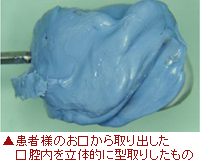 First we determine the height of the upper and lower teeth. Then we determine the position of the upper and lower jaw.
First we determine the height of the upper and lower teeth. Then we determine the position of the upper and lower jaw.
It takes about 5 minutes for the mold to harden, so we have you breathe slowly through your nose during this time. We collect very valuable information in the meantime.
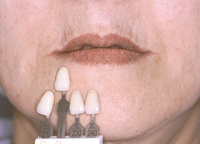 We also use this time to have you select your artificial teeth. Artificial teeth used in full dentures made through the maxillomandibular simultaneous impression method use a functionally and esthetically superior design by Dr. Strack. We discuss with the patient and take into consideration things like skin color and face outline when choosing the teeth.
We also use this time to have you select your artificial teeth. Artificial teeth used in full dentures made through the maxillomandibular simultaneous impression method use a functionally and esthetically superior design by Dr. Strack. We discuss with the patient and take into consideration things like skin color and face outline when choosing the teeth.
After we have measured precisely the state of the upper and lower jaw and have placed it in the actuator, we then line up the selected artificial teeth. We form the gums with wax.
The human jaw is extremely precise and a discrepancy of just a few millimeters can be felt. Because of this, we place the mold into a device that mimics the movements of the jaw (an actuator) in order to make sure that there is no awkward feeling in the mouth.

5. We conduct the pre-completion check
We will have you put in the wax dentures in order to conduct a pre-completion check.
+ Esthetic check ... check the shape and color of teeth, etc.
+ Fit check ... check to see that dentures fit right and do not jostle
+ Pronunciation check ... check to make sure you can pronounce words correctly
+ Bite alignment check ... check to see that you can bite firmly without difficulty
These are the types of things we check for.
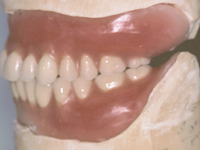 After this we replace the wax dentures with ones made of long-lasting hard materials (synthetic resin and metal). The retention of the dentures will be completely different from when you had your teeth. There will be nothing but a foundation in your jaw.
After this we replace the wax dentures with ones made of long-lasting hard materials (synthetic resin and metal). The retention of the dentures will be completely different from when you had your teeth. There will be nothing but a foundation in your jaw.
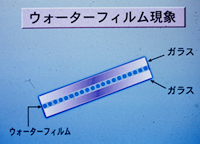 Full dentures use the water-film phenomenon (the same mechanism that causes 2 layers of glass to stick together firmly when a layer of water lays between them) to ensure that they will not fall out.
Full dentures use the water-film phenomenon (the same mechanism that causes 2 layers of glass to stick together firmly when a layer of water lays between them) to ensure that they will not fall out.
This is why we must make your dentures so that they match up perfectly with the contours of the shape of the gums in your jaw. This operation is called polymerization. After polymerization, the dentures are completed after they have been buffed and polished.

6. Final check [completion]

We put in your beautifully polished dentures. Then we make the final check for esthetics, fit, bite alignment, pronunciation, and retention force.
You will not be used to your new dentures immediately after you put them on for the first time so there may be slight awkwardness or pain. But dentures made correctly will certainly get better with slight adjustment.
With dentures that fit just right, you will be able to eat foods that have an elasticity to them, such as pickles, meat, squid, and octopus, without any worry of your dentures coming out. You will also be able to speak confidently without worrying. Moreover, our dentures barely ever cause discomfort so you can sleep with them in at night. It will be as if our full dentures are a part of your own body. Please enjoy the freedom you will gain from using them.
2009年4月15日
An advanced [Telescope] case treated with Riegel telescope restores a patient's ability to bite
[Riegel telescope case]
A patient came to us wearing dentures with magnetic clasps saying, "I can't bite into things..." The strength of the magnetic clasps was such that the dentures could be removed by hand. It is no wonder that they came loose easily when chewing food.
Riegel telescope dentures use a small locking mechanism placed on their inner side. The dentures can be put on and taken off by opening and closing this lock. There is never any risk of them slipping off while eating.
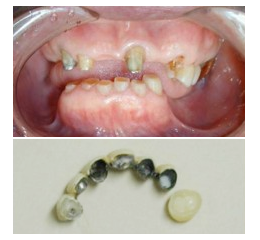 This case was extremely complicated. The patient only had front teeth left on the upper jaw and was using a simple set of dentures. The problem was the bottom teeth. The bottom front teeth were greatly worn down and as for the back teeth, the bones had completely absorbed the dentures.
This case was extremely complicated. The patient only had front teeth left on the upper jaw and was using a simple set of dentures. The problem was the bottom teeth. The bottom front teeth were greatly worn down and as for the back teeth, the bones had completely absorbed the dentures.
The patient came to our clinic extremely troubled because they were not able to eat and their dentures easily broke.

First, we reinforced and repaired the patient's usable teeth. Since the patient's bite alignment plane was also off, we aligned it to achieve bilateral symmetry. This is where we put false teeth into the upper jaw. At this point, the patient was overjoyed to regain the ability to bite.
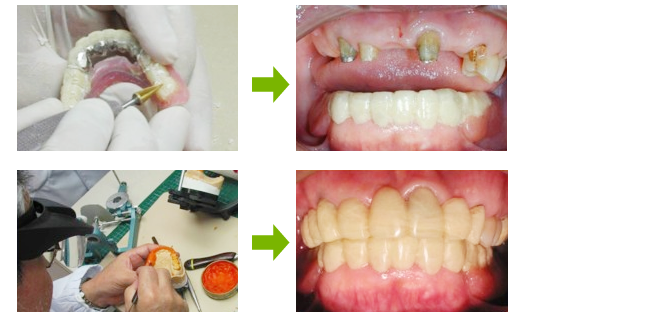
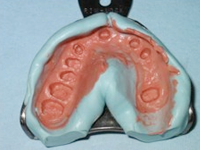 After making a wax mold and examining it, we decided to use Riegel telescope to fix the condition of the upper and lower teeth. The pictures below are of precision molds we had taken.
After making a wax mold and examining it, we decided to use Riegel telescope to fix the condition of the upper and lower teeth. The pictures below are of precision molds we had taken.

The finished upper and lower Riegel telescope dentures.


The picture on the left shows the lock (Riegel lever) in the closed position while the picture on the right shows it in the opened position.
The lock can be easily opened and closed using a finger, and when it is closed it is unnoticeable to the tongue. It helps to think of it as a kind of removable bridge.
Since the prosthetic teeth are ceramic, the final product is esthetically beautiful. The metallic parts are completely hidden when the dentures are set in place inside the mouth.
*Cases introduced on the website are completely unique to the patients and actual treatment periods and methods vary for each patient.
A case concerning severe gingivitis and dentures
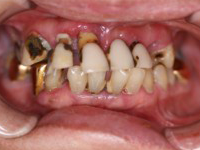 This patient came to our clinic suffering from gingivitis and bad breath. The patient shared that they were aware of how bad their situation was and decided to visit us to take care of the problem once and for all.
This patient came to our clinic suffering from gingivitis and bad breath. The patient shared that they were aware of how bad their situation was and decided to visit us to take care of the problem once and for all.

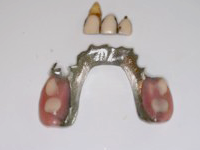 Unfortunately, the patient's front teeth were loose and there was nothing we could do to preserve them. In this case we had to extract the loose teeth.
Unfortunately, the patient's front teeth were loose and there was nothing we could do to preserve them. In this case we had to extract the loose teeth.

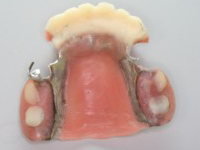 Before we extracted the patient's teeth, we altered the dentures so that they wouldn't have to go around with no front teeth after the extraction. We made false teeth for the front ones and reinforced the upper jaw so that the patient could bite again.
Before we extracted the patient's teeth, we altered the dentures so that they wouldn't have to go around with no front teeth after the extraction. We made false teeth for the front ones and reinforced the upper jaw so that the patient could bite again.
Normally when teeth are extracted it is necessary to leave the area open for a while which can hinder the patient's lifestyle. In order to spare the patient from this negative experience, we establish a treatment plan in advance.

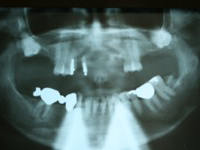 We extracted 2 teeth from the upper jaw and used 4 others to support Resilience telescope dentures. There were more teeth left in the lower jaw but since many of them were loose due to pyorrhea, we chose the Riegel telescope method which would secure and link them together.
We extracted 2 teeth from the upper jaw and used 4 others to support Resilience telescope dentures. There were more teeth left in the lower jaw but since many of them were loose due to pyorrhea, we chose the Riegel telescope method which would secure and link them together.

We attached inner crowns to the upper jaw and used them to snap the Resilience telescope dentures into place.


We secured the loose teeth of the lower jaw by linking them with an inner crown, which was further secured with the Riegel telescope dentures that fit over them.


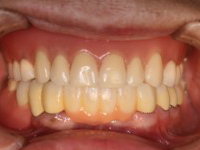 This is when we set the dentures in place in the patient's mouth. Only white is visible making these dentures undetectable to other people.
This is when we set the dentures in place in the patient's mouth. Only white is visible making these dentures undetectable to other people.

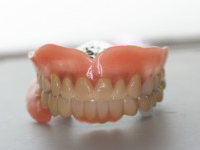
The patient was very pleased after putting the dentures on and shared with us that they wanted to hurry up and go out to talk and smile with new people. This was significant as the patient had had a complex about talking and smiling before they came in.
We are always very pleased to see this patient's beautiful smile each time they come in for maintenance.
*Cases introduced on the website are completely unique to the patients and actual treatment periods and methods vary for each patient.
2009年4月14日
Keep your dentures and remaining teeth for a long time through periodic maintenance
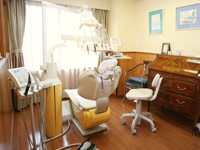 Maintain the health of your teeth and continue to use your dentures and your remaining teeth for a long time through maintenance. In order to be able to use your dentures as long as possible, prevention is the key. Of course it is important to brush your teeth every day, but we also recommend that you come in to the clinic periodically for tooth cleaning.
Maintain the health of your teeth and continue to use your dentures and your remaining teeth for a long time through maintenance. In order to be able to use your dentures as long as possible, prevention is the key. Of course it is important to brush your teeth every day, but we also recommend that you come in to the clinic periodically for tooth cleaning.
Remove stains impervious to regular brushing with our supersonic scaler
Tooth cleaning carried out by dentists or dental hygienists is carried out using a special device that removes stains called a supersonic scaler. This is especially useful on plaque caused from the attaching of calcium in saliva to plaque that is impossible to remove through regular means such as brushing.
Even if there are no specific problems, you can prevent cavities and pyorrhea by having your teeth cleaned periodically by a dentist or a dental hygienist. This will also make you more concerned with your teeth and raise your awareness of your own oral condition. This results in positive effects on dental health.
On the other end of the spectrum, there is a very high risk that people who are never examined by a dentist are late in discovering major abnormalities in their mouth, and when they finally are aware of their gingivitis (pyorrhea), it is too late.
In the case of dentures, some people don't think that it is necessary to get maintenance if they can bite comfortably. But, when dirt builds up, this can lead to bad breath, and it doesn't look very nice either. Especially in the case of partial dentures, without proper maintenance, the teeth acting as a support for the dentures can develop gingivitis and fall out.
Riegel telescope dentures from Inaba Dental Office can be adjusted should the patient lose teeth, but in the case of regular dentures covered by health insurance, dentures need to be remade each time a tooth falls out. Because of this, periodic maintenance is very important in order to prevent the loss of even just one tooth.
So would you rather play it safe and come in for maintenance and keep your dentures for a long time? Or do you prefer to continue to lose your teeth and have new dentures made each time?
In order to protect your important teeth and use your teeth comfortably, we suggest coming in for maintenance once every 3 months (periodic checkup).
*Maintenance cost is 12,000 yen each time.
Here is an explanation of the maintenance procedure
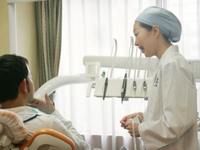 1. First we ask the patient about the condition of their mouth.
1. First we ask the patient about the condition of their mouth.

2. Next we check each tooth individually for cavities using a magnifying glass. It is particularly easy for cavities to develop in the spaces between teeth, so we also check to make sure you are flossing.

3. We then use a supersonic device to remove plaque from the surface of the teeth. The dental hygienist will use an item called a scaler to neatly remove plaque from deep pockets between the teeth and gums.

4. We then clean discoloration from the teeth and then finish them off with a machine brush.

5. We then massage the gums by going over all teeth with an interdental brush.

6. Finally the dental hygienist provides advice on how to brush properly, and if you wish we also apply fluoride.
For dentures, we perform supersonic cleaning, brush clean any teeth that are discolored, and then check to make sure that nothing is broken. Our Riegel telescope dentures should last a lifetime with proper maintenance.
Also, remember that your own teeth are assets that help you lead a fulfilling life. No matter how high the level of technology, artificial teeth can never compare to natural ones. We are happy to do whatever we can to in order to protect your remaining teeth.
2009年4月13日
[Full dentures] are loose and the patient can't bite. They experience pain when moving their mouth
[First visit]
The patient came to our clinic stating the following reasons:
+ "My dentures are so loose that I cannot bite. It hurts every time they move..."
+ "It is a bother to talk in front of people".
The patient told us that they had an inferiority complex about their teeth.
![[Full dentures]](/images/case015.png)
They wanted us to help alleviate the pain so they could enjoy eating and get over their inferiority complex. We decided to treat with full dentures made using the maxillomandibular simultaneous impression method to address the patient's pressing concerns.
[Taking the first mold impression]
Comparing the dentures that the patient came in with to their teeth mold, we found out that the dentures where smaller than the space in the patient's mouth and were nearly completely lacking support from the mouth muscles.
![[Full dentures]](/images/case016.png)
![[Full dentures]](/images/case017.png)
We made a tool based on this model to create a precise mold.

[Second visit to the clinic]
![[Full dentures]](/images/case018.png) The picture below is of the Gothic arch. It is used to record the movements of the jaw. In this case the jaw movements were normal.
The picture below is of the Gothic arch. It is used to record the movements of the jaw. In this case the jaw movements were normal.

Using the upper tray, we take a precise mold of the upper and lower jaw. At this time we are simultaneously recording the position of the jaw in regards to the central point of the body, and measuring the height of the bite alignment.
As the mold is being taken, we have the patient swallow their saliva in order to recreate the state of the mouth muscles while eating.
![[Full dentures]](/images/case019.png)
![[Full dentures]](/images/case020.png) After taking the mold, we choose artificial teeth that match the patient's skin color and facial features.
After taking the mold, we choose artificial teeth that match the patient's skin color and facial features.

![[Full dentures]](/images/case021.png) We transfer the myriad data to a bite alignment device called an actuator. Then we make the dentures using this model.
We transfer the myriad data to a bite alignment device called an actuator. Then we make the dentures using this model.

We create a shape using wax before the dentures are complete, line up the artificial teeth and then check everything. This is when we make detailed checks for things like pronunciation, comfort, and esthetic beauty.
![[Full dentures]](/images/case022.png)

![[Full dentures]](/images/case023.png) We conduct polymerization using the Ivocup-System. This transforms the wax into a hard material.
We conduct polymerization using the Ivocup-System. This transforms the wax into a hard material.

This is when the completed dentures were first placed into the patient's mouth. We insert a bite alignment lead called a 'full-balanced occlusion'. The information put into the actuator matched up perfectly with the conditions inside of the patient's mouth.
![[Full dentures]](/images/case024.png)
We made a few final adjustments after putting the dentures in and the patient is now able to enjoy them as if they were a part of his own body. The patient was also very pleased that pronunciation improved dramatically thanks to the dentures.
*Cases introduced on the website are completely unique to the patients and actual treatment periods and methods vary for each patient.
My body is in no condition to go through implant surgery...
Q. My body is in no condition to go through implant surgery...
A. This is not a problem. There is no need for surgery as with implants.
We can treat your case within the scope of normal dental treatment. We can adapt to the needs of patients who were told that implants are too difficult, elderly patients, and patients who suffer from a range of systemic diseases.
I would like to get implants, but it is too expensive because I need so many.
Q. I would like to get implants, but it is too expensive because I need so many.
A. In this situation we recommend that you use the telescope system.
Dentures made using the telescope system link together and fix remaining teeth in place. These dentures are superior functionally and esthetically and they help prevent further tooth loss. They feel like your own teeth and no one can tell that you are wearing dentures.
If you only have a few teeth remaining, the telescope system is almost always more economical than getting implants.
I'm in my 40s. Should I just get implants?
A. If your remaining teeth are strong and you are only missing a few of them, then implants may be the right choice for you. If you only have a few remaining teeth and you require many implants, it would be cheaper and more effective to choose the telescope system.
If you are only missing a few teeth but you suffer from advanced pyorrhea or many of your teeth are missing nerves, it is reasonable to assume that you will lose more teeth and therefore it would be better to choose the telescope system for treatment.
This is because the telescope system links together and firmly fixes teeth in place helping to prevent further tooth loss. Even if you happen to lose more teeth, your dentures can continue to be used with only minor adjustments.
How many years do dentures last?
Q. How many years do dentures last?
A. Telescope system dentures have a very long history. Some dentures made in Japan 31 years ago, when the technology was first used in Japan, are still in use today.
When we administer treatment using dentures (telescope system), we spend a lot of time designing them with the patient's condition in mind so that they can be used for a long time. Because of this, our dentures can be used for a very long time and many of our patients tell us that they have become a part of their bodies.
What should I do if my dentures break?
Q. What should I do in case my dentures break?
A. In the same way that earthenware that is dropped and then repaired is liable to break again in the same spot, our dentures can also be repaired. However, we ask that you take very good care of them since they may lose some structural integrity
One feature of telescope system dentures is that they can be taken off, even after breaking, and repaired. Even still, we ask that you please take very good care of them.
Is it necessary to use denture adhesives?
Q. Is it necessary to use denture adhesives?
A. There is no need to use denture adhesives.
The membrane portion that uses denture adhesives, and the method used to make the gums (polymerization) are completely different from dentures covered by insurance. Our dentures are made using the Ivocup System, which allows them to make use of the water-film phenomenon (this is the same phenomenon that causes two panes of glass to stick firmly together when a layer of water lays between them). The retention created by this phenomenon is so great that there is no space left between the dentures and the mouth to use denture adhesives.
Should I take out my dentures before going to bed?
Q. Should I take out my dentures before going to bed?
A. With full dentures and partial dentures, we recommend that you take them out to brush them clean, put them back in, and then rest with them in. According to a survey of full denture wearers from Japan and Germany, many Germans sleep with their dentures in while many Japanese take them out. It seems that many people are afraid to be seen by their family members without their dentures.
There were many people who lost their dentures during the Great Hanshin Earthquake because they took them out at night. If you clean your dentures well at night, then you can sleep with them in.
Is it true that it is difficult to speak clearly with dentures in?
Q. Is it true that it is difficult to speak clearly with dentures in?
A. When the top portion of full dentures is thick, this can impede the movement of the tongue and make it difficult to clearly pronounce words. When the lower portion of full dentures extends back behind the tongue, this can also impede the movement of the tongue and make pronunciation difficult in the same way.
Telescope system full dentures that use the maxillomandibular simultaneous impression method are made upon careful examination so as to make pronunciation easy. We even have patients who can pronounce English without any problems with their dentures in.
I heard that it becomes harder to taste food...
Q. I heard that it becomes harder to taste food...
A. Loss of the ability to taste food is a comprehensive problem. The tongue can taste sweet, spicy, salty/spicy, sour, bitter, and many other flavors. The ability for your membrane to detect the warmth or coolness of food dullens as the membrane gets thicker.
Foods like squid and natto that have a gooey texture easily stick to dentures making them more difficult to taste. With these factors it is true that some foods become harder to taste when wearing dentures.
Dentures made using the maxillomandibular simultaneous impression method are made to be 1.5 millimeters thick. Also, the membrane portion of the dentures can be made with metal with a thickness of 0.5 millimeters. With our ultra-thin dentures it is easier to detect warmth and easier to enjoy flavors.
Is there any chance that my dentures will just suddenly come off?
Q. Is there any chance that my dentures will just suddenly come off?
A. Since Riegel telescope dentures use a small locking mechanism, there is no risk of the latch spontaneously coming undone and your dentures falling out.
Can people see the metal on my partial dentures?
Q. Can people see the metal on my partial dentures?
A. Partial dentures covered by insurance use metal springs called clasps that are visible to people around you. Telescope system dentures use nothing of the sort meaning that metal is not visible even when you laugh.
I can't eat anything hard. Is there anything I can do to fix this?
Q. I can't eat anything hard. Is there anything I can do to fix this?
A. If your dentures move around inside your mouth then it will be very difficult to make a clean bite through hard food. Dentures made at Inaba Dental Office do not move inside the mouth so you can enjoy even the hardest of foods with no problems.
The artificial teeth in our dentures are Strack design. They are made using the latest research and development in the field of artificial tooth shape and with much consideration given to jaw movements. These teeth are made with much attention given to the anatomical shape of natural teeth and they feature natural groves that aid in the chewing of food.
What kinds of foods will I be able to eat?
Q. What kinds of foods will I be able to eat?
A. One patient who was treated at Inaba Dental Office with the telescope system likes to tell us what she has been able to eat each time she comes in. So just the other day, we asked her, "If you don't mind, could you please make a list of what kinds of foods you are now able to eat?" This is how she responded*
☆ 彡:・;.*:・。゜゜・:゜*:。゜.*。゜.o。・。゜。o.゜。・*。・゜.。☆彡
*Sushi rolls and regular sushi
I can bite into them, chew them good, and swallow. When I had inlays, I was unable to pull with my teeth so I had to dissect the larger sushi rolls and have the smaller ones cut into 1 cm pieces. Kampyo rolls were especially difficult. The kampyo and the seaweed would just get flattened out and I would have to swallow it like that or break the rules of manners and pull it apart. I love sushi and having the chef roll them fresh in front of me at the counter is one of my joys in life. It was tough before always having to consult with my teeth on what types of sushi I could eat, especially squids and clams were particularly hard to bite. I haven't tried abalone yet but I can firmly bite into ark shell clams, cockles, and mirugai clams.
*Oranges and other citrus fruits
I can bite into orange wedges and chew the pulp in my mouth now without any problems. When I visit a friend's house or go out to eat, I often encounter orange wedges or other citrus fruit wedges... I've always wanted to eat them but I felt like it wouldn't be a good idea with dentures. At home I used to peel and eat citrus fruit by the bushel. My husband and daughter had to eat the same way... It was kind of a side-effect of my condition.
*Uncooked vegetables
I used to get so worried when someone would take out a raw radish, unpeeled and cut into eighths. Now I am so grateful that I can bite into these easily now. I can now eat cucumbers, takuan, and kinpira, without hesitation.
*Pie
I now can eat flaky pie crust with no problems. Pie crust used to be quite high level for me but since I like it so much, I used to cut it into small pieces to eat. It was far from beautiful eating form so I only ate pie alone at home in secret.
I am so happy that I can now eat many different things. And I am even happier that I do not need to cover my mouth every time I speak. That truly is the greatest joy. You have always been so polite when treating me and always have a smile on your face. I was able to go through the treatment process without feeling any apprehension. I am always grateful. You helped me overcome a complex that I have had for a long time. If I notice anything else, I'll gladly let you know.
The patient who shared the above message with us came in for tooth cleaning with her husband the other day.
Of course she regained the ability to eat. She also had her bite evened on the left and right side of her jaws. This creates a nice muscular balance and leads to a wonderful full face.
This type of feedback always brings us a lot of joy.
Thank you very much.
What is the locking mechanism on Riegel telescope dentures?
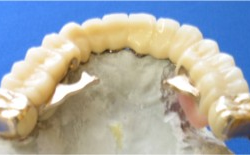 Riegel telescope dentures use a dual covering method for the teeth. After you set them and fix them in place, you can remove them by using the integrated small locking mechanism.
Riegel telescope dentures use a dual covering method for the teeth. After you set them and fix them in place, you can remove them by using the integrated small locking mechanism.
Remove the dentures by opening the lock. When you close the lock, the device cannot be felt by the tongue so there is no uncomfortable feeling.
There are two different locking mechanisms according to the condition of the patients remaining teeth. They are called Schwenk Riegel, and Dray Riegel. There are other locking mechanisms that I have actually seen in Germany, but these two are superior.
Are there false teeth I can use while waiting for my dentures?
Q. Will you provide me with false teeth while I wait for my dentures?
A. Of course we will make you false teeth.
Be relieved to know that we will make sure that no one can tell that you are undergoing treatment.
We receive many questions from patients worrying about going around with missing teeth while their dentures are being made. We take various measures to make sure that no one can tell that our patients are undergoing treatment.
It would be impossible to eat and communicate without your teeth during treatment. This can cause your family to worry as well.
At our clinic, we absolutely provide false teeth for our patients while they wait for dentures.
Before having your teeth removed, we make a set of false teeth based on an assumption of the condition of your mouth post-extraction. It is very important to us to consider the esthetic and functional recovery of our patients' oral condition after extraction
We also provide support throughout treatment to help our patients feel at ease and get used to false teeth. I don't think that you need to worry about any negative effects at work.
By making you a set of false teeth, you can continue to eat healthily even while undergoing treatment.
The telescope system requires an extremely high level of precision which means that even the slightest change of tooth position can throw the process off. False teeth are extremely important because they help prevent teeth from moving.
My gums have become thin. Can I still get dentures?
A. Yes, you can. It is generally difficult to have implants put in with thin gums. And it is also considered a difficult case even with full dentures. But full dentures that make use of the muscles around the mouth, even for patients with thin gums, can be made using the maxillomandibular simultaneous impression method. Even with thin gums, these dentures adhere firmly and will not come out (this is because they can make use of the water-film phenomenon).
*Water-film
This is the phenomenon when two plies of wet glass adhere firmly when placed on top of one another.
How long is the treatment period?
The telescope system offered at our clinic involves a very complicated manufacturing process and the technical work requires time. The situation differs case by case, but it usually requires 4 visits starting with the first one where a mold of your jaw is taken.
The process proceeds according to plan and even when the dental technician is completely focused on one project, it can take from 3 - 4 weeks before we are ready to have you come in for the next step.
It is different in each case, but it typically takes 3 - 4 months from taking the first mold to receiving your dentures.
(Full dentures are done completely through appointment and there is a course that can be completed in 3 days.)
Also, in the unfortunate case that you absolutely must have teeth extracted, we ask that you wait six months before having a mold taken so that your bone has a chance to stabilize. In the meantime, we provide false teeth and support so that you can freely continue your daily activities without drawing attention to your oral condition.
Do I need to have teeth extracted to get dentures made?
Q. Do I need to have teeth extracted to get dentures made?
A. There is no need to have teeth extracted unless you have an advanced case of pyorrhea and your teeth are loose.
Slightly loose teeth can be fixed into place with dentures.
We try to make the most use of teeth that look like they may need extraction in the future. And even if we have to extract those teeth, you can still use your same dentures with only slight adjustments.
2009年4月12日
Might you have TMJ arthrosis?
Do you suffer from any of the following symptoms?
+ Do you clench or grind your teeth?
+ Do you feel pain or stiffness in your jaw?
+ Do you often get headaches or pain in the neck? And is it worse when clenching?
+ Does the pain when clenching get worse when you feel stressed?
+ Does your mouth pop or creak when you open it? Is it difficult to open your mouth?
+ Do you have any other types of arthrosis or problems in your joints?
+ Is it difficult to clench your teeth for a long time?
+ Does your bite alignment change from time to time?
+ Is it difficult to clench or tear food with your front teeth?
+ Are your teeth sensitive? Do they move, crack, or are they worn down?
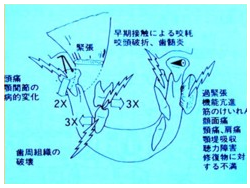 If you are suffering from any number of the symptoms listed above, it is likely that you may have TMJ arthrosis. Since there are many causes of TMJ arthrosis, it is almost always very difficult to know whether or not the jaw is the source of the problem.
If you are suffering from any number of the symptoms listed above, it is likely that you may have TMJ arthrosis. Since there are many causes of TMJ arthrosis, it is almost always very difficult to know whether or not the jaw is the source of the problem.
Symptoms of TMJ arthrosis
☑tooth wear
☑nerve pain from tooth wear (sting when touching hot or cold)
☑inflamed gums ☑root pain ☑grinding
☑pain in jaw joints ☑pressure pain in jaw joints ☑neck or head pain
☑ringing in the ears ☑difficulty hearing ☑loss of sensation in hands or feet
☑uneven posture (unable to keep balance)
TMJ arthrosis treatment varies according to the symptoms.
Treatment begins with a detailed search for the causes.
All Examination Rooms Are Private Rooms
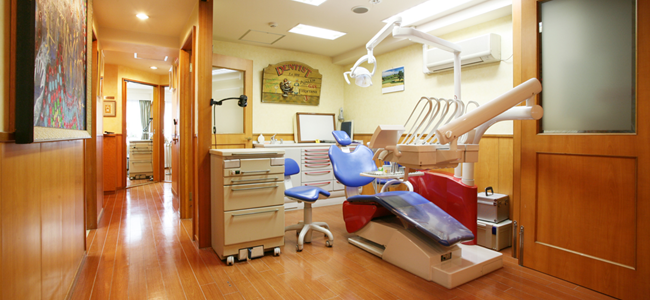
We have 3 fully private examination rooms prepared for our patients. They are interior decorated to make our patients feel at home, complete with pictures and antique furniture.

TMJ arthrosis caused by dentures
Some patients complain saying, "I cannot open my mouth wide", or "There is pain in the joints around my jaw". Upon further examination the number of middle-aged patients who complain of the following symptoms is increasing:
+ "I have stiff shoulders."
+ "My back aches."
+ "I have lost sensation in my arms and legs."
+ "There is ringing in my ears."
+ "I get terrible migraines."
These are all symptoms of TMJ arthrosis.
TMJ arthrosis is a condition in which the area around the jaw hurts, opening the mouth becomes difficult, and a clicking or scraping noise can be heard coming from the jawline area. TMJ arthrosis is considered an ailment common in people in their 20s and 30s due to bad tooth alignment, or an unbalanced bite caused by wisdom teeth.
However, cases of TMJ arthrosis in middle-aged patients are mostly attributed to poor bite alignment due to silver crowns and especially dentures.
If you wear dentures and suffer from any of the symptoms listed above, please contact us for consultation. We can fix your bite alignment and help alleviate your discomfort.
2009年4月11日
Cases of TMJ arthrosis caused by dentures
A patient who came in complaining of pain in the right jaw and the inability to open his mouth straight.
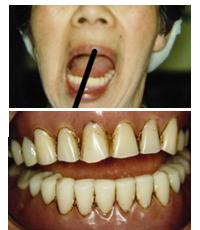 [state of the mouth when opened]
[state of the mouth when opened]
Seen from the front, it is obvious that the jaw has shifted to the left.
[state of dentures]
Looking at the dentures, it can be seen that the teeth on the left side are more worn down than those on the right side.

We took an X-ray of the joints in the jaw. We were able to diagnose that the articular disk on the left-hand side was shifted forward and had lost function.


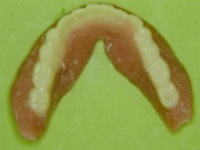 Since this treatment method was to be carried out before making new dentures, we duplicated the patient's dentures, lowered the front of the lower jaw and raised the right side of her bite by 2 millimeters to give her smooth movement. We confirmed that she was able to open her mouth straight using the duplicate dentures and after making sure there was no more pain in the jaw, we remade her dentures.
Since this treatment method was to be carried out before making new dentures, we duplicated the patient's dentures, lowered the front of the lower jaw and raised the right side of her bite by 2 millimeters to give her smooth movement. We confirmed that she was able to open her mouth straight using the duplicate dentures and after making sure there was no more pain in the jaw, we remade her dentures.

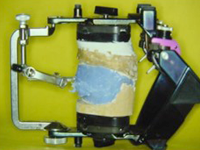 We take a mold of Inaba-style full dentures using the maxillomandibular simultaneous impression method.
We take a mold of Inaba-style full dentures using the maxillomandibular simultaneous impression method.
What are full dentures made using the maxillomandibular simultaneous impression method?

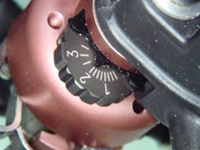 We used the PDRI Insert of the KaVo PROTAR actuator, a device used to measure bite alignment, to adjust the patient's bite alignment by lowering the front of the lower jaw in order to provide her with smooth jaw movement.
We used the PDRI Insert of the KaVo PROTAR actuator, a device used to measure bite alignment, to adjust the patient's bite alignment by lowering the front of the lower jaw in order to provide her with smooth jaw movement.

Dentures were made after we confirmed that the right jaw needed to be lowered by 2 millimeters during the jaw function exam by creating a graph using CADIACS and setting the PDR insert to 0 and then again to 2 millimeters.

We were able to alleviate the patients jaw pain with these dentures and they also allowed her to open her mouth straight.

This treatment method produces dentures that allow movement of the jaw joints. This particular case was rather complicated and required Dr. Shigeru Inaba's wide range of knowledge. It is very likely that using dentures that do not fit correctly over a long period of time may lead to TMJ arthrosis.
2009年4月10日
Full dentures made using the maxillomandibular simultaneous impression method
Upper and lower full dentures (base price) .... 3,240,000 yen
(4 to 5 visits to the clinic are necessary)
For 3 days of consecutive treatment .... 5,400,000 yen
(This plan requires the dentist and technician to allot three full days to only one patient)

The process of treating TMJ arthrosis (an actual case)
During the initial exam we found that the patient could not open her mouth and that she experienced pain when she tried to do so. Her right jaw made a snapping noise. She shared with us that she was constantly worried about the area in front of her right ear and that it was effecting her work.
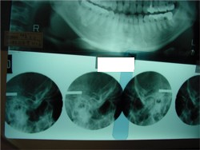 At first glance, it seemed that there were no obvious problems with the inside of her mouth. To the right is an X-ray image of the inside of her mouth. The many crowns and fillings in her molars stand out, but there was no problem with the shape of her jaw.
At first glance, it seemed that there were no obvious problems with the inside of her mouth. To the right is an X-ray image of the inside of her mouth. The many crowns and fillings in her molars stand out, but there was no problem with the shape of her jaw.

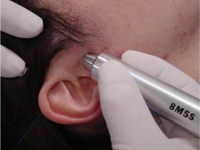 We examined the joints of her jaw using a Doppler stethoscope. We listened to find out whether the snapping noise occurred when she opened her jaw or when she closed it. In this patient's case, a snapping sound occurred in the joints on the right side when she opened her jaw. She was also unable to open her jaw straight.
We examined the joints of her jaw using a Doppler stethoscope. We listened to find out whether the snapping noise occurred when she opened her jaw or when she closed it. In this patient's case, a snapping sound occurred in the joints on the right side when she opened her jaw. She was also unable to open her jaw straight.


The second time she came to the clinic we took a mold and examined it. This is after we added plaster to the mold of her upper and lower jaw and neatly trimmed it.

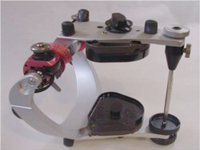 We then attached the mold to a device called an actuator, which can accurately reproduce jaw movements. The angle of jaw movement is different in each person. The jaw movement is always quite complex when people grind their teeth. The jaw rotates and moves back and forth and to the left and right. It is necessary in TMJ arthrosis patients to undergo this detailed examination.
We then attached the mold to a device called an actuator, which can accurately reproduce jaw movements. The angle of jaw movement is different in each person. The jaw movement is always quite complex when people grind their teeth. The jaw rotates and moves back and forth and to the left and right. It is necessary in TMJ arthrosis patients to undergo this detailed examination.

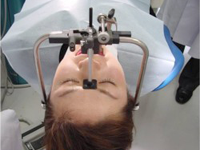 This is a face-bow transfer. It is a device used to attach the upper jaw mold to the actuator. We can use it to examine whether or not the bite alignment plane is vertically aligned with the midpoint of the body. It is important to use the face-bow transfer even when making just a single crown or filling.
This is a face-bow transfer. It is a device used to attach the upper jaw mold to the actuator. We can use it to examine whether or not the bite alignment plane is vertically aligned with the midpoint of the body. It is important to use the face-bow transfer even when making just a single crown or filling.

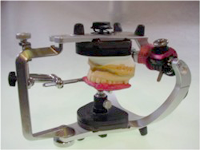 This is how we transfer the recorded data to the actuator. The relationship between the midpoint of the body (midpoint of the actuator) and the bite alignment is transferred accurately.
This is how we transfer the recorded data to the actuator. The relationship between the midpoint of the body (midpoint of the actuator) and the bite alignment is transferred accurately.

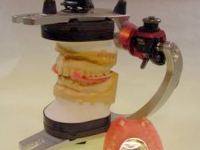 It is not enough that the upper and lower bite alignment meet at only a particular location when biting. We record the central position (the original position where the jaw is most relaxed) and then attach the upper and lower teeth.
It is not enough that the upper and lower bite alignment meet at only a particular location when biting. We record the central position (the original position where the jaw is most relaxed) and then attach the upper and lower teeth.

Then we check to see if there are any changes between the position of the jaw when relaxed and the position when biting. In this patient's case, the reconstructed (fixed) fillings and crowns turned out to be the cause of her symptoms. This mold examination is extremely important and teaches us a lot about the condition. A high level of skill is required to master this examination technique.(IPSG)


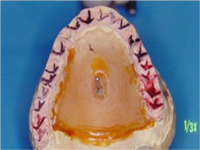 There are many grooves hidden inside of the shape of teeth. These are not random imperfections, but they actually follow rules.
There are many grooves hidden inside of the shape of teeth. These are not random imperfections, but they actually follow rules.

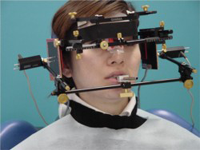 The third time the patient visited the clinic we record the movements of her jaw in 3-D and examined her jaw function. We record how her jaw movement has changed after treatment compared to before treatment.
The third time the patient visited the clinic we record the movements of her jaw in 3-D and examined her jaw function. We record how her jaw movement has changed after treatment compared to before treatment.

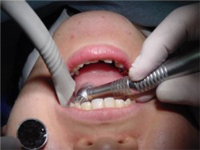 It varies per case, but usually during the fourth visit we administer sprint therapy or instruct the patient on how to perform home therapy. In this patient's case, since the cause of her symptoms was unbalanced bite alignment due to fillings and crowns, we carried out occlusal adjustment.
It varies per case, but usually during the fourth visit we administer sprint therapy or instruct the patient on how to perform home therapy. In this patient's case, since the cause of her symptoms was unbalanced bite alignment due to fillings and crowns, we carried out occlusal adjustment.
Occlusal adjustment needs to be monitored and is usually complete after being carried out 1 to 3 times.

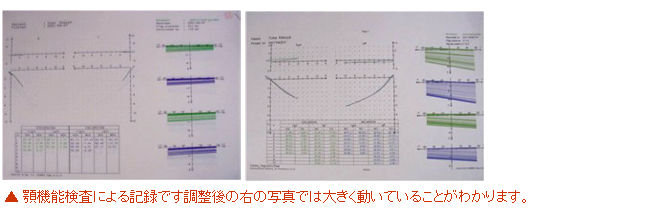
After adjustment, the patient was cured of the snapping noise in her right jaw joints. She also regained the ability to open her mouth straight. You can see from the image to the left that her jaw was barely moving at all. The image to the right shows that she was able to move and open her jaw widely after adjustment.
The patient was very pleased. She told us that she initially thought the pain was a result of being tired from work, but after treatment she was able to happily return to work in good health.
*TMJ arthrosis treatment is not covered by national health insurance and we charge 10,000 yen (tax not included) for the first examination.
2009年4月 9日
Dental medical expense deductions?
Medical expense deductions refer to a certain amount of tax deduction you may receive in case you have paid medical expenses for you or someone in your family.
Costs related to denture treatment are eligible for medical expense deductions. Medical expense deductions are part of a system put into place to reduce the financial burden of medical costs. If you must spend more than 100,000 yen in one year on medical costs, then a portion of your income tax will be returned to you.
In the case that medical expenses are incurred by a person or a spouse or other family members supported by that person (between January 1 and December 31 of each year), and these expenses are reported by March 15 of the next year, then that person can receive back a portion of their tax as a medical expense deduction or their tax burden will be lightened.
However, if medical expenses do not exceed 99,999 yen in one year, then no deductions can be made (the amount reported cannot exceed 2,000,000 yen).
People whose gross income does not exceed 2,000,000 yen can report medical expenses that equal or exceed 5% of their income.
Medical costs that can be written off as medical expense deductions
- Examination and treatment costs paid to a doctor or a dentist
- Cost of pharmaceuticals used for treatment
- Transportation costs associated with travelling to and being admitted to the hospital (train fares, bus fares, taxi fares etc.)
- Costs of masseuses, acupuncturists, and moxibutionists for treatment
- Others
Requisites to receive a return of funds
- Tax return (income earner's withholding slip)
- Receipt (must be original, no copies)
- Official stamp (inkan) and bank/etc. passbook
*Your tax return can be retrieved at your local tax office.
*The declaration period is between February 16 and March 15 of the following year. However, salaried employees can receive their returns from January of that year.
If you paid for treatment with a dental loan
A dental loan is when a patient has a credit company front the money for dental treatment and must pay back the amount in installments. In this case, the patient is eligible for medical expense deductions the same year that the credit company fronted the amount.
Moreover, In the case of dental loans, it is possible that the patient will not be in possession of the receipt. If this is the case, a copy of the contract with the credit company can be used.
*Please be informed that interest and processing fees are not eligible for medical expense deductions.
2009年4月 7日
We aim to provide a stress free dental clinic.
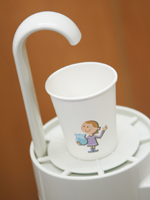 This is a stress free dental clinic. The dental clinic is a place patients are never really excited about visiting. Many people come for the following reasons:
This is a stress free dental clinic. The dental clinic is a place patients are never really excited about visiting. Many people come for the following reasons:
+ "I lost a filling"
+ "I am in pain"
We take every measure to make sure that patients who visit our clinic receive treatment without feeling stressed.
For example, it is often the case that patients coming in for their first exam tend to feel anxious. We are well aware of this and do all that we can to help patients relax. We have chosen an at-home interior decorating style and we strive for a soothing and warm atmosphere in which are patients can feel at ease.
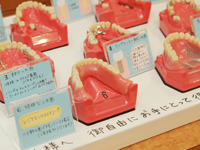 Anyone suffering from disease is bound to feel stress. Even during such uncomfortable times, kind treatment can ease some of the stress.
Anyone suffering from disease is bound to feel stress. Even during such uncomfortable times, kind treatment can ease some of the stress.
It is our primary goal to build a warm and trusting relationship with our patients. Therefore we endeavor every day to maintain a stress free clinic.
A dental practice that doesn't really feel like a dental clinic
 A dental practice that doesn't really feel like a dental clinic
A dental practice that doesn't really feel like a dental clinic
Since our clinic is located on the 6th floor of a small building in the Akihabara electronics district, our location doesn't really stand out. You may not believe that there is a dental clinic inside of this small building when you first see it from the outside. We have just one small billboard outside.
When patients take the elevator up to the 6th floor, they may not think that they have arrived at a dental clinic (our clinic is specifically designed not to look like a run-of-the-mill dental clinic).
We do not keep our patients waiting
Simply waiting in a waiting room can be a stressful experience so consultations and examinations at our clinic are by appointment only.
There is nothing pleasant about being made to wait for other patients coming and going. Not to mention, it is an added source of stress for our staff who cannot break concentration while providing treatment.
Rather than actually 'waiting' in the waiting room, patients usually tend to just worry about whether or not the day's treatment will hurt. Wouldn't it be nice to use that time thinking about more pleasant things?
Feel free to enter our clinic in your outdoor shoes.
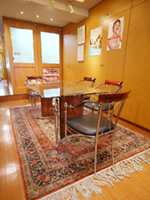 We would also have you enter our waiting room and examination room in your own shoes. Our staff cleans every day and the floors are waxed once a month.
We would also have you enter our waiting room and examination room in your own shoes. Our staff cleans every day and the floors are waxed once a month.
Changing into slippers worn by multiple strangers can also cause patients stress. Almost all restaurants and high-end hotels allow you to wear your own shoes these days. So please feel free to enter our clinic as you are.
2009年4月 6日
When my patients are happy, I am so happy that I skip home.
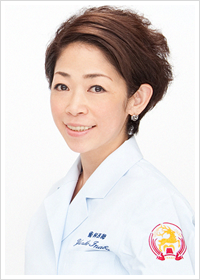 Currently I have a husband and 2 daughters. We are a family of 4. I love taking trips. When I was single I used to take trips by myself to Europe. Now I dream about travelling the world and visiting wonderful places with my family.
Currently I have a husband and 2 daughters. We are a family of 4. I love taking trips. When I was single I used to take trips by myself to Europe. Now I dream about travelling the world and visiting wonderful places with my family.
The source of my happiness is the wonderful smiles of satisfied patients.
The source of my happiness is my family and friends, and making my patients happy as a dentist. No matter how many times I see the spectacular smiles (and teeth) of my patients, I am always overjoyed. Those days fill me with so much pride and happiness that I just want to skip home from work!
Do you avoid going to the dentist because you are afraid that it is going to hurt?
At our clinic we provide tooth treatment and especially denture treatment that aims to bring happiness back to the lifestyles of our patients who have lost teeth. If you are worried about full dentures or partial dentures, or if you have had to have dentures remade time and time again because they don't fit correctly, please leave it to Inaba Dental Office.
We make dentures that will leave you wondering if you even have them in your mouth since chewing any type of delicious food will be easy and people will not notice them. Our staff works together all day to ensure that our patients can achieve a spectacular smile.
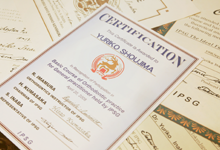 [Brief Background]
[Brief Background]
1997Graduated, Nippon Dental University, Received Dentist License1997Resident, Nippon Dental University1998Resident (1 year), Anesthesiology Department, Toho University Ohashi University Hospital1999Inaba Dental Office opens (current post)*Received various training in Germany and Switzerland
[Affiliations]
Japan Academy of Esthetle Dentistry
Member, ISOI International Society of Oral Implantology
Certified Dentist, Academy of Clinical Dentistry
General Affairs, IPSG
Member, Germany Chamber of Commerce
2009年4月 5日
Advisor Shigeru Inaba, a pioneer in Riegel Telescope
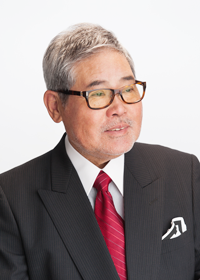 He introduced the highly advanced Riegel Telescope method into Japan and has since used it to treat more than 1000 cases.
He introduced the highly advanced Riegel Telescope method into Japan and has since used it to treat more than 1000 cases.
At a meeting of the Academy of Clinical Dentistry held from June 20 to June 21 of this year, he introduced a production method for full dentures using the maxillomandibular simultaneous impression method for difficult cases.
On top of serving as the top advisor for IPSG, he continues to provide and research the best dental treatments.
[Brief Background]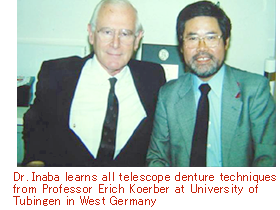
1964Graduated, Nippon Dental University1968Graduated, Nippon Dental University Graduate School1969Lecturer, Prosthetics Class, School of Dentistry, Nippon Dental University1972Assistant Professor, Prosthetics Class, School of Dentistry, Nippon Dental University1978Exchange Student, University of Tubingen, West Germany, Visiting Professor under Professor E. Koerber1992Professor, Department of Gerodontology, School of Dentistry, Nippon Dental University19993rd Lecture Professor, Prosthetics Class, School of Dentistry, Nippon Dental UniversityCurrent IPSG (Interdisciplinary Practical Study Group) Comprehensive Dental Treatment Research Group Representative
[Affiliations]
- Standing Director, Japanese Society of Gerodontology
- Trustee, Japan Geriatrics Society
- Trustee, Japanese Society for the Study of Chronic Pain
- Trustee, Japanese Society of Dental Practice Administration
- Trustee, (Corp.) Japan Oral Health Association
- Trustee, (Corp.) Oral Health Association
- Trustee, Japanese Association for Toothfriendly Sweets
- Top Advisor, IPSG (Interdisciplinary Practical Study Group)
- President, Japanese Society of General Oral Medicine
[Reliable technology learned from famous overseas doctors]
 Professor Willy Schulte was teaching about TMJ arthrosis at the University of Tubingen when I travelled there as an exchange student to study the topic. It was meeting this gifted professor that inspired me to make the study of TMJ arthrosis the theme of my life.
Professor Willy Schulte was teaching about TMJ arthrosis at the University of Tubingen when I travelled there as an exchange student to study the topic. It was meeting this gifted professor that inspired me to make the study of TMJ arthrosis the theme of my life.
I also learned the muscle palpation diagnostic method from Professor Kropol in the field of TMJ arthrosis. I also received actual instruction on bite alignment from Professor Jankleson, Professor Lauritzen, and Professor Eichner.
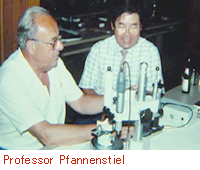 Dental technician, Professor Pfannenstiel taught me the milling technique for Konus telescope.
Dental technician, Professor Pfannenstiel taught me the milling technique for Konus telescope.
Professor Charles E. Stewart is a famous American who is famous for being the father of nanology. I am greatly influenced by his lessons on the fundamentals of nanology including jaw movements and tooth shape.

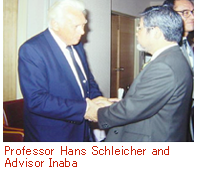 Also, when Professor Hans Schleicher retired, he left all of his resources concerning full dentures to Advisor Inaba. Many other great dentists have contributed to the clinical practice of Advisor Inaba.
Also, when Professor Hans Schleicher retired, he left all of his resources concerning full dentures to Advisor Inaba. Many other great dentists have contributed to the clinical practice of Advisor Inaba.
Introduction of Dr. Tomohiro Inaba (Yamabukicho Clinic)
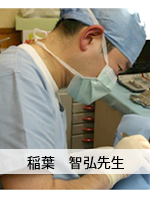 [Brief Background]
[Brief Background]
1999Graduated, Nippon Dental University Graduate School2000Completed Dentist Clinical Training2004Graduated, Nippon Dental University Graduate School (Oral Surgery Department) Doctor of Dentistry
Assistant, Pharmacology Lecture, Faculty of Dentistry, Nippon Dental University2005Clinical Assistant, University Hospital Oral Surgery, Nippon Dental University2006Full-time Employee, Oral Surgery, Yokohama Minami Kyosai Hospital2007Assistant (current), University Hospital, Nippon Dental University
[Affiliated Societies]
- Member, Japanese Society of Oral and Maxillofacial Surgeons
- Member, Japanese Society for Jaw Deformities
- Member, Japan Academy of Gnathology and Occlusion
- Member, Japan Academy of Esthetle Dentistry
- Member, Japan Society for Oral Myofunctional Therapy
- Bite Alignment Certified Doctor, Japan Academy of Gnathology and Occlusion
[Social Activities]
- Secretary General, IPSG (Interdisciplinary Practical Study Group) Comprehensive Dental Treatment Research Group
- Member, Uonuma Mushroom Association
2009年4月 4日
Legal Advisor Shigekazu Iwai
Tokyo Bar Association 24th Term
[Career and Affiliations]
Born in Chikuma City, Nagano
1968Graduated, Faculty of Law, Department of Law, Chuo University1972Registered as Attorney, Law Offices of Takahiko Kimiya1974Regular Member, Tokyo Bar Association1976Established, Law Offices of Shigekazu Iwai1982Regular Member, Tokyo Bar Association1989Executive Secretary, Legislative Counsel System Subcommittee 1990Changed name of law practice to Law Offices of Iwai and Yasuda 1991Vice-president, Tokyo Bar Association1992Regular Member, Tokyo Bar Association1997Changed name of law practice to Act Law Offices2004President of Tokyo Bar Association, Vice-president of Japan Federation of Bar Associations2005 Vice-president, Japan Legal Aid Association
Chairman, Japan Federation of Bar Associations Attorney Investiture Promotion Center2006Manager, Japan Legal Support Center Project
Planning Department (2006 - 2007)2008Manager, Japan Legal Support Center Full-time Attorney Promotion Department(2008 - 2009)2010Participation, Japan Legal Support Center
Chairman, Japan Federation of Bar Associations Attorney Ethics Committee
Chairman, Japan Federation of Bar Associations Legal Symposium Operations Committee2011and 2012 Special participation, Japan Legal Support Center
(Supreme Court) Lower Court Judge Appointment Inquiry Committee Member2013 and 2014 Chairman, Japan Federation of Bar Associations Attorney Ethics Committee
(Supreme Court) Lower Court Judge Appointment Inquiry Committee Member
Director, Housing Reform Foundation / Dispute Settlement Support Center
(Land, Infrastructure and Transportation Ministry Jurisdiction)
Director, NPO Corporation Medical Information Communication Technology System Support Organization
Controller, All Japan Seal Industry Foundation
Councilor, Japanese Association of Cardiovascular Intervention and Therapeutics2015Recipient, Order of the Rising Sun
[Important works and writings]
'Discussion Road Traffic Law' (Yuhikaku) Joint Authorship
'6 Car Laws Q&A' (Yuhikaku) Joint Authorship
'6 Car Accident Laws Q&A' (Yuhikaku) Joint Authorship
'Traffic Accident Legal Consultation' (Yuhikaku) Co-authored
'6 Rules of Lifestyle Q&A' (Yuhikaku) Co-authored
'Japanese Knowledge - A book for potential judges' Author (CK Publishing)
...and others
Onsite Dental Technician Office
Our own specialist dental technician works onsite in the dental laboratory annexed to our clinic. He provides for our patients with meticulous skill and we have made it so that you can watch him at work from the waiting room. Please have a look if you would like to know how your teeth are made.
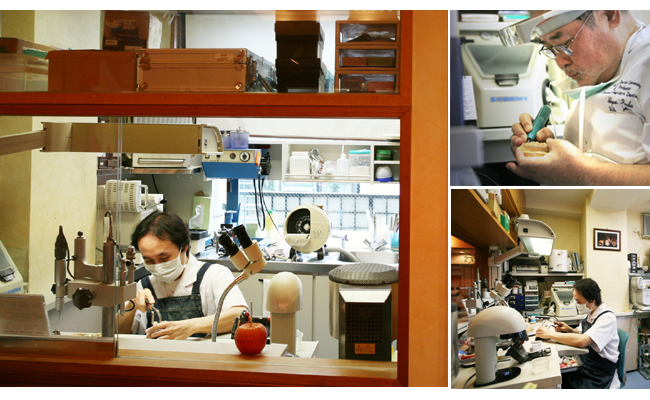
Pictures by Advisor Inaba
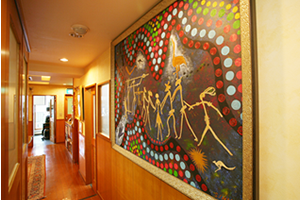 Our clinic is craftily decorated with many paintings and European objets d'art for our patients' viewing pleasure.
Our clinic is craftily decorated with many paintings and European objets d'art for our patients' viewing pleasure.
This painting was painted by our advisor, Dr. Shigeru Inaba. It is a painting made using the Australian Aborigine dot paint and rock art method. It is an expression of the many conditions of the oral cavity.
Doctors' Robes
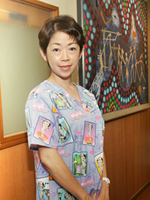 Visiting the hospital can be an anxious experience. Even though it is quite different, some people feel this way about the dental clinic as well. They feel stress and their pulse increases and blood pressure rises just by seeing the doctors' and nurses' white robes.
Visiting the hospital can be an anxious experience. Even though it is quite different, some people feel this way about the dental clinic as well. They feel stress and their pulse increases and blood pressure rises just by seeing the doctors' and nurses' white robes.
This is called white coat syndrome and beginning with the United States, it is beginning to be recognized in medical communities around the world.
Our staff dawn uniforms decorated with friendly characters to reduce stress felt by the patients. We also maintain a clean and fresh look.
2009年4月 3日
Directions to Clinic
6F Tanaka Bldg., 4-7-3 Sotokanda, Chiyoda Ward, Tokyo 101-0021

See a larger map (Google Map)
【By train】
Take the Tokyo Metro Ginza Line and get off at 'Suehirocho Station'.
Leave from Exit 1 and it takes less than 1 minute.
7 minutes from 'Akihabara Station' using JR or Tokyo Metro Hibiya Line
⇒Head towards Ueno from Akihabara's electronic district (Chuo Road).
Click here for directions from Akihabara Station
【By taxi】
About 10 minutes by taxi from Tokyo Station.
Ask to be dropped off at the intersection at 5-chome in Sotokanda, or at Suehirocho Station on the Ginza Line.
【By bullet train】
From Tokyo Station

【By plane】
From Haneda Airport

Directions from Akihabara Station
 1. Get off at the JR Akihabara Station. Exit from the gate that leads to the electronics district and head right out of the station exit.
1. Get off at the JR Akihabara Station. Exit from the gate that leads to the electronics district and head right out of the station exit.
 2. There is a public square when you exit the station.
2. There is a public square when you exit the station.
 3. Walk straight to your left-hand side in the square.
3. Walk straight to your left-hand side in the square.
 4. Turn left at Excelsior Café and go straight.
4. Turn left at Excelsior Café and go straight.
 5. Keep going until you reach the intersection.
5. Keep going until you reach the intersection.
 6. Cross the crosswalk (Chuo Street) on the right-hand side of the intersection.
6. Cross the crosswalk (Chuo Street) on the right-hand side of the intersection.
 7. You should be able to see Don Quixote on the right. Continue straight keeping Don Quixote to the right.
7. You should be able to see Don Quixote on the right. Continue straight keeping Don Quixote to the right.
 8. Cross at the first crosswalk that doesn't have a traffic light.
8. Cross at the first crosswalk that doesn't have a traffic light.
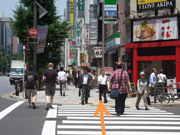 9. Cross at the second crosswalk that doesn't have a traffic light.
9. Cross at the second crosswalk that doesn't have a traffic light.
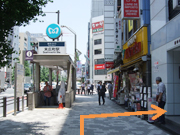 10. You will see the Tokyo Metro Suehiro-cho Station entrance. Inaba Dental Clinic is on the 6F of the Tanaka Building, which is right in front of the station entrance.
10. You will see the Tokyo Metro Suehiro-cho Station entrance. Inaba Dental Clinic is on the 6F of the Tanaka Building, which is right in front of the station entrance.
2009年4月 2日
IPSG組織概要
【IPSG事務局】
代表 :稲葉 繁 前日本歯科大学教授
会長 :飯塚 能也 埼玉県・飯塚歯科医院院長
副会長 :岩田光司 千葉県・ひかり歯科医院院長
一般社団法人 IPSG包括歯科医療研究会
IPSG事務局
〒101-0021
東京都 千代田区外神田4-7-3
田中ビル5階
TEL 03-3525-8314
FAX 03-3525-8317
E-MAIL: IPSG.8028@gmail.com
HP: http://www.ipsg.ne.jp/
2009年4月 1日
Concerning Personal Information
Inaba Dental Clinic (hereinafter referred to as 'our clinic') may request personal information from all patients when making appointments, consulting, requesting information materials, and in other situations. Our clinic has created this 'privacy policy' concerning all personal information provided to us, and we take every precaution to handle this information with the utmost care.
Concerning Personal Information Gathered from This Site
Personal names, e-mail addresses, and other personal information that is asked when making appointments, consulting, or requesting information material is necessary for accurately scheduling appointments, conducting consultation, and gathering accurate information. Information collected will not be used for any purposes other than those stated here.
Concerning Release of Personal Information
As a rule, this site will not release users' personal information.
Concerning Use and Provision of Personal Information
Our clinic will not sell or lend any personal information given in response to questions. Below are listed the only circumstances under which personal information will be provided to outside entities.
* When the user consents to provision
* Should we receive an official demand of inquiry based on the law from a public institution such as the court or the police
* Information may be released in the case that a company entrusted by our clinic to do business should need said information for the purpose of providing service to the user. (However, these companies may not use personal information outside of the aforementioned limits.)
Moreover, information gathered through consultation may be posted on this site and on other sites related to our clinic should it be deemed to have public service value. In those cases any details that may reveal the identity of the user will not be posted publicly.
Our clinic's personal information custodian
Yukiko Inaba, Director
Inaba Dental Clinic
6F Tanaka Bldg., 4-7-3 Sotokanda, Chiyoda Ward, Tokyo, 101-0021

